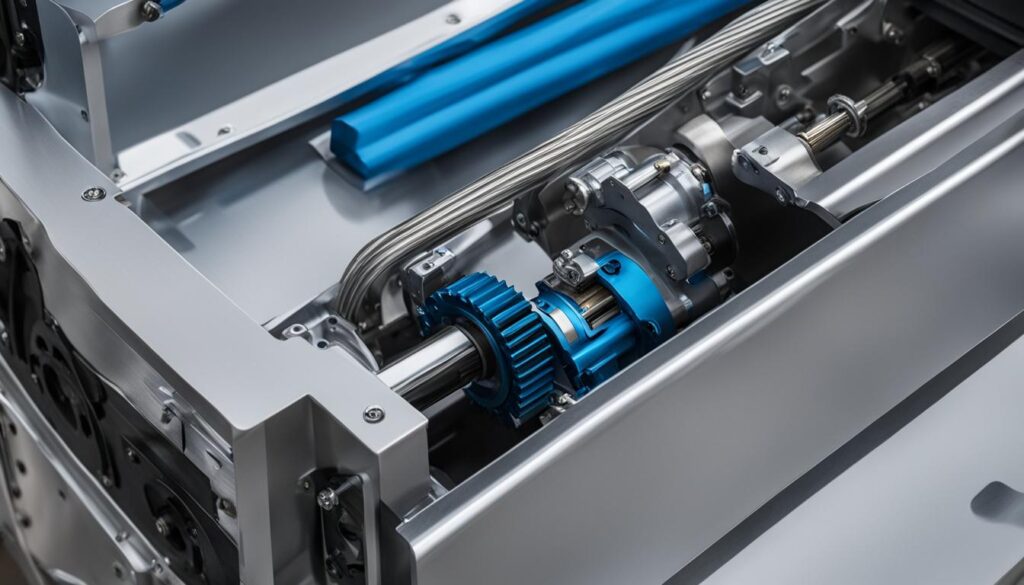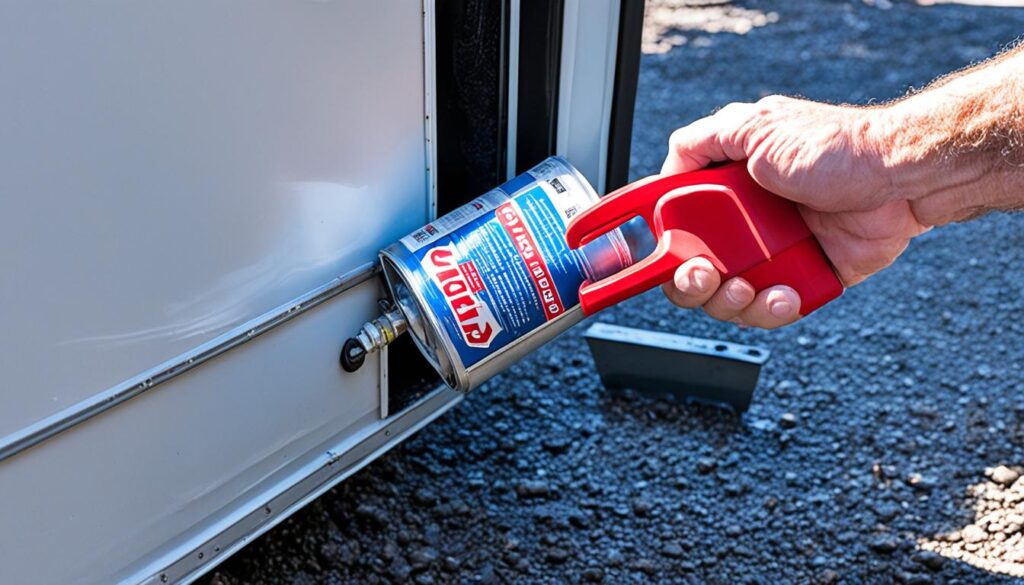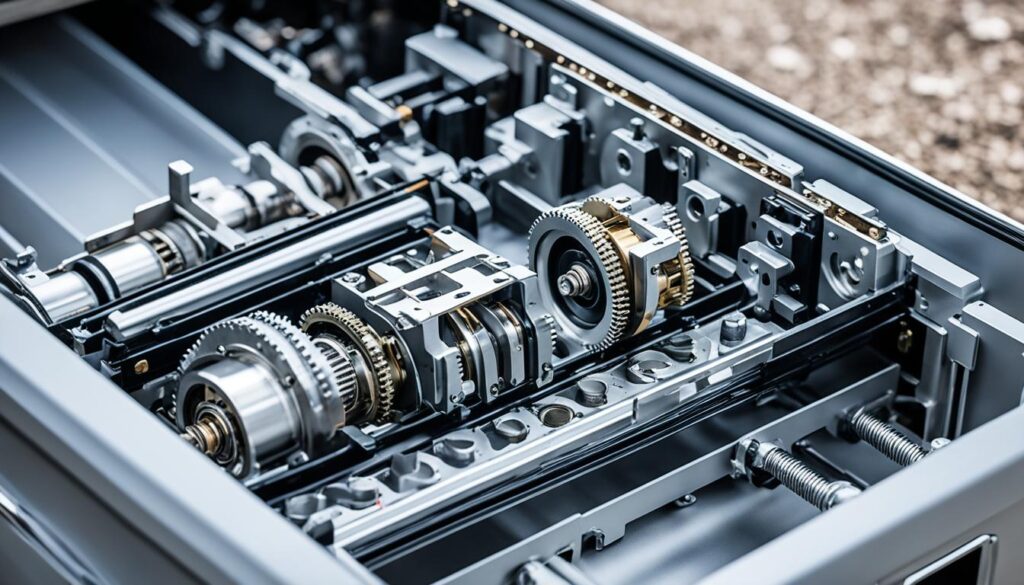Have you ever wondered how those nifty RV slide outs magically create extra space inside your mobile home? Whether you’re an avid traveler or a curious observer, understanding the mechanics behind RV slide outs can be fascinating. So, how exactly do they work? Let’s dive into the intricate world of RV slide out mechanisms and uncover their secrets.
Key Takeaways:
- RV slide outs are extensions that can be added to an RV to increase living space.
- There are various types of RV slide out mechanisms, including electric, hydraulic, rack and pinion, cable, Schwintek, and power gear slides.
- Each mechanism has its advantages and considerations, such as weight, cost, maintenance, and floor flush capability.
- Proper operation, maintenance, and troubleshooting are essential to ensure the smooth operation of RV slide outs.
- Preventing damage to moving cables in the slide out mechanism is crucial to avoid malfunctions and hazards.
Contents
RV Slide Out Diagram and Components
Understanding the construction of an RV slide-out is essential for RV owners looking to gain additional living space. Let’s explore the key components that make up an RV slide-out and how they contribute to its functionality.
The main component of an RV slide-out is the slide-out room itself. This is the section of the RV that moves in and out, creating extra space when needed. The slide-out room is attached to a slide-out mechanism, which enables it to extend and retract smoothly.
Aside from the room and mechanism, other vital components include:
- Seals: These are crucial for preventing water, air, and debris from entering the RV when the slide-out is extended. They ensure a tight seal and protect the interior from damage.
- Controls: These are located inside the RV and allow for the easy operation of the slide-out. Depending on the model, controls may include buttons, switches, or touchscreens.
- Supports and Stabilizers: These components provide stability and level the slide-out when extended. They play a crucial role in maintaining the structural integrity of the slide-out and ensuring a safe and comfortable living environment.
- Slide-Out Toppers: These are optional accessories that provide shade and protect the slide-out from debris such as leaves and branches. They help keep the slide-out area clean and prolong its lifespan.
Here is an RV slide out parts diagram to illustrate the various components:
Understanding the different components of an RV slide-out is essential for proper maintenance and troubleshooting. By familiarizing yourself with these components and their functions, you’ll be better equipped to ensure the smooth operation and longevity of your RV’s slide-out.
How Do Different RV Slide Out Mechanisms Work?
RV slide outs can significantly enhance the living space of an RV, providing comfort and convenience on the road. These slide outs utilize different mechanisms to extend and retract, catering to diverse needs and preferences. Let’s explore the various RV slide out mechanisms:
1. Electrically Driven Slides:
Electrically driven slides are a popular choice in RVs. They employ an electric motor to extend and retract the slide. This mechanism offers smooth operation and is relatively easy to maintain. Electrically driven slides come in different variants:
- Rack and Pinion Slides: These slides use a circular gear that moves against another gear or rack, allowing for controlled and precise movement.
- Cable Slides: Cable slides utilize a cable and pulley system to extend and retract the slide. This mechanism is known for its reliability and durability.
- Schwintek Slides: Schwintek slides employ worm gears and rails to move the slide in and out smoothly. They are widely used due to their space-saving design and quiet operation.
- Power Gear Slides: Power gear slides are lightweight and hidden beneath the slide. They offer efficient operation and are popular in modern RV designs.
2. Hydraulic Slides:
Hydraulic slides use a motor-driven hydraulic pump to push the slides in and out. This mechanism provides robust and reliable operation, making it suitable for larger and heavier slide outs. Hydraulic slides excel in terms of power and force, but may require additional maintenance compared to electrically driven slides.
3. Cable Slides:
Cable slides, as mentioned earlier, leverage a cable and pulley system to extend and retract the slide. This simple yet effective mechanism is known for its strength and durability. Cable slides are commonly found in many RV models.
The choice of slide out mechanism depends on various factors, such as weight capacity, cost, maintenance requirements, and desired floor flush capability. Each mechanism has its advantages and considerations, catering to different RV owners’ needs and preferences.

Tips for Proper RV Slide Out Operation and Etiquette
Proper operation and etiquette are crucial for ensuring the smooth functioning of your RV slide outs. By following these tips, you can maintain the longevity and effectiveness of your RV slide outs:
- Extend the slide outs when the RV is parked and level: It’s important to extend your slide outs only when your RV is parked on level ground. This ensures that the slide outs operate correctly without putting strain on the mechanism.
- Leave enough space on the sides: Before extending the slide outs, make sure there’s enough space on the sides for them to fully extend. This prevents any potential damage to the RV or surrounding objects.
- Level the RV before extending: Prior to extending the slide outs, it’s recommended to level your RV using leveling blocks or jacks. This ensures that the slide outs extend evenly and reduces the risk of any complications.
- Avoid extending slide outs while driving: Never extend the slide outs while driving or in motion. This can cause serious damage to the slide out mechanism, as well as compromise your safety and the safety of others on the road.
- Be mindful of weight distribution: When the slide outs are extended, there’s extra weight on one side of the RV. It’s important to be mindful of this imbalance and adjust your RV’s overall weight distribution accordingly.
Following these tips will help you maintain the optimal operation and performance of your RV slide outs, ensuring a seamless and enjoyable experience during your travels.
Ensuring Slide Out Maintenance and Troubleshooting
Regular maintenance is essential for keeping RV slide outs operating smoothly and preventing potential issues. By following a few key maintenance practices and knowing how to troubleshoot common problems, RV owners can ensure their slide outs function properly and extend their lifespan.
Maintenance Tips for RV Slide Outs
- Inspect Visible Mounting Points: Regularly check the visible mounting points of your RV slide out for any signs of wear or damage. Look for loose bolts or screws that may need tightening.
- Check Seals and Gaskets: Inspect the seals and gaskets around the slide out to ensure they are intact and free from cracks or tears. Damaged seals can lead to leaks and decreased insulation.
- Apply Seal Conditioner: Use a seal conditioner product specifically designed for RV slide outs to keep the seals supple and prevent them from drying out or cracking. Apply the conditioner according to the manufacturer’s instructions.
- Monitor Abnormal Noises or Variations in Speed: Pay attention to any unusual noises or changes in the speed of your slide out when extending or retracting. These can be indicators of underlying mechanical issues that may require maintenance or repairs.
Troubleshooting RV Slide Outs
If you encounter problems with your RV slide out, troubleshooting can help identify the issue and determine the necessary actions. Here are some general troubleshooting tips:
- Refer to the Owner’s Manual: The owner’s manual for your RV should provide specific troubleshooting instructions tailored to your slide out mechanism. It’s essential to have a copy of the manual on hand for reference.
- Visit the Manufacturer’s Website: RV manufacturers often provide resources and troubleshooting guides on their websites. Check the manufacturer’s website for any relevant information related to your specific slide out mechanism.
- Seek Professional Assistance: If troubleshooting does not resolve the issue or if you are unsure about performing repairs or maintenance yourself, it’s recommended to seek professional assistance from a certified RV technician.
By following these maintenance practices and troubleshooting tips, RV owners can ensure the smooth operation of their slide outs and address any issues promptly. This not only enhances the overall camping experience but also helps prolong the lifespan of the RV slide outs.

| Maintenance Practice | Importance |
|---|---|
| Inspect visible mounting points | Ensures structural integrity and prevents loose connections |
| Check seals and gaskets | Prevents leaks and maintains insulation |
| Apply seal conditioner | Keeps seals supple and prevents drying out or cracking |
| Monitor abnormal noises or variations in speed | Identifies potential mechanical issues that may require attention |
The Importance of Preventing Damage to Moving Cables
When it comes to RV slide out mechanisms, preventing damage to the moving cables is of utmost importance. By ensuring proper alignment and regular inspection of the cables, you can prevent pinching and potential damage to critical components such as electrical, water, and gas lines. This proactive approach not only helps to avoid malfunctions but also minimizes the risk of hazards.
An effective way to safeguard the cables is by using cable carriers. These carriers provide a dedicated pathway for the cables, keeping them safe and free from obstructions during the extension and retraction of the slide outs. By implementing this precautionary measure, you can significantly reduce the chances of cable damage.
Additionally, regular inspection and lubrication of the seals and gaskets can contribute to preventing damage to the overall slide out mechanism. By ensuring that all components are in good condition and properly lubricated, you can extend the lifespan of your RV slide out system and maintain its optimal functionality for years to come.
FAQ
How do RV slide outs work?
RV slide outs use various mechanisms, such as electric, hydraulic, rack and pinion, cable, Schwintek, and power gear slides, to extend and retract the slide-out room, providing additional living space in the RV.
What components make up an RV slide out?
An RV slide out consists of the slide-out room, slide-out mechanism, seals, controls, supports and stabilizers, and slide-out toppers, all working together to extend and retract the slide-out.
What are the different types of RV slide out mechanisms?
There are electrically driven slides (including rack and pinion, cable, Schwintek, and power gear slides) and hydraulic slides. Each mechanism operates differently and has its advantages and considerations.
What are some tips for proper RV slide out operation and etiquette?
It’s important to only extend slide outs when the RV is parked and level, leave enough space on the sides for the slide to extend, level the RV before extending the slide, and follow slide out etiquette, such as not extending slides while driving.
How should I ensure slide out maintenance and troubleshoot any issues?
Regular maintenance includes inspecting mounting points, checking seals and gaskets, and identifying any abnormal noises or variations in speed. Troubleshooting should be done following the owner’s manual or manufacturer’s instructions.
What steps should I take to prevent damage to moving cables in RV slide outs?
To prevent damage, ensure proper alignment and inspection of cables, use cable carriers, avoid obstructions during extension and retraction, and regularly inspect and lubricate seals and gaskets.






